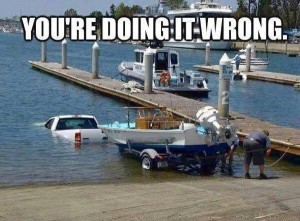Minnesota Boat Repair | Collision Boat Repair
Ahhhh! Nothing says summer like boating! With 11,842 lakes, 69,200 miles of rivers and streams and about 4,000 miles of water trails, boating is a favorite pastime for outdoor activity in Minnesota. There’s something about the boating lifestyle that more people are discovering as the ultimate escape. Whether you enjoy fishing or just a quiet boat ride, you will find beautiful Minnesota Lakes in every corner of the state. And since the very root of the word Minnesota (mni) comes from a Dakota Indian word meaning “water,” it just seemed right that thousands of boaters take advantage of the state’s most famous natural resource.
Continued from Part 1
Be a Nice Boater!
Don’t be THAT guy!
You know the one. They tick off everyone in line to use a boat ramp by skipping in line, using more space than needed and being unpleasant to be around.
During the summer, some of our Boating Access Areas (We’re looking at you,) can become awfully busy and chaotic. It’s hot. It’s crowded. And folks just want to get on the water. Here are a few tips to make the boating experience pleasant for everyone.
Don’t be this person. Be safe and be considerate — when you hit the boat ramp this summer!
Float Planning….Don’t Leave Shore Without It!
File a float plan with a responsible person.
Before you go out on the water, you should leave a Float Plan with someone you trust, so they’ll know what to do if you don’t come back on time. Your Float Plan could be in the form of a note or a voice-mail, but to be sure you’ve included all of the relevant information you should take a look at the Coast Guard Float Plan form (PDF). While you’re downloading documents, you might also want to grab a sample Pre-Departure Checklist (PDF) to keep on your boat.
Why should you take the time to prepare a float plan? The answer is simple… there are just too many facts that need to be accurately remembered and ultimately conveyed in an emergency situation. Without a float plan you are counting on someone else, a friend, neighbor, or family member to remember detailed information that rescue personnel need in order to find you. Information that can make a difference in the outcome.
Who should prepare a float plan?
Don’t think for a minute that this is a tool only for those with big expensive boats. A Float Plan is equally effective for the owner of a 10 foot kayak or flat-bottom skiff as it is for a 48-foot express cruiser, or a 90 foot sport-fishing vessel or luxury yacht. So, what kind of boaters prepare float plans?
- Kayakers
- Sport fisherman
- Hunters
- Jet Skiers
- Water skiers
- Family day cruisers
- Private charter boat services
- Canoeists
- Rowers
- Rafters
- Sail boaters
- Power boaters
Considering the number of boaters we share our waters with, boating and fishing are basically safe pastimes. But that doesn’t mean that you couldn’t have an accident through your own or someone else’s ignorance of these basic safety rules. As a boater or fisherman, you have an obligation to yourself, your passengers and other boaters to make sure you have all required safety equipment on board. We also have separate equipment checklists and vessel system checklists.
Check the charge on fire extinguisher(s).
Check that your registration and decal are up-to-date and your registration card is on board.
Will You Be Seen In Time?
Check Your Navigation Lights
Review Navigation Lights – Flash Movie
Make sure all running gear, navigation lights, etc., are working. Out of order navigational lights is a leading cause of boating accidents.



